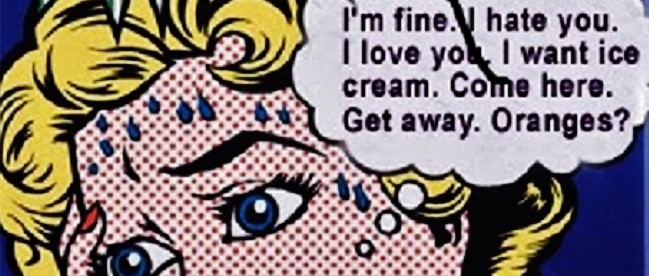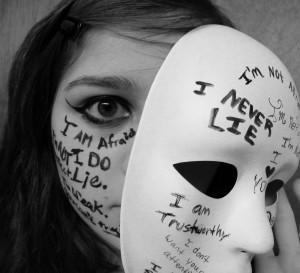Living in Two Worlds: Borderline Personality Disorder
Every Wednesday, I had a special “class” with Mrs. O, the counselor at my elementary school.
The classes were private and we played fun games that required a lot of talking. I didn’t like to talk much but when Ms. Patsy – the peach-hued puppet who assisted Mrs. O – talked in her funny voice and I had a block of bright clay to squeeze in my hand, I was able to open up.
Ms. Patsy told me that I was “different”, which I thought was a good thing at the time. That’s how our favorite heroes and heroines start out, right? Different.
A little more than a decade later, I realized that “different” is bad.
Surrounded by the vomit-yellow walls of the hospital ward, ringing with the cries of the bed-strapped, the moaning of the withdrawal-stricken, and the ceaseless shuffling of the dead-eyed around the room, I was confronted by the dreadful realization that what made me “different” was what put me in this room.
Rewind to my elementary days in the detention room, my parents pleading to the dean that I’m “just a misunderstood kid”, to the paranoid teen years when everyone was “against me”, to my bedroom thrashed to shambles in a violent fit of rage, and fast forward to the colbalt and pearl Tylenol PM pills piled in my hand; a reckless solution to sleep forever that put me in that vomit-colored ward.
I learned its name, the thing that made me different: Borderline Personality Disorder, or BPD. According to the National Institute of Mental Health, BPD is a serious mental illness marked by instability in moods, behavior, and relationships. It’s a Cluster B personality disorder characterized by impulsivity and is highly comorbid with other issues such as mood disorders, substance abuse, and suicide ideation.
The diagnosis with BPD at the age of 21 flipped my world. I researched the illness studiously, becoming fascinated by the textbook descriptions accurately capturing my world:
1. I nearly always feel “empty.”
2. I often engage in reckless, deleterious, or dangerous activity.
3. I am often very paranoid, especially in times of stress, and feel myself “spacing out” or dissociate.
4. “Splitting” defines every paradigm in my life. Everything exists only in black or white. I struggle to understand that people make mistakes and can still be good people.
5. How I view myself, others, and the world undergoes violent shifts several times through the day or week.
6. I’m terrified of rejection and disapproval and would go to irrational lengths to prevent it.
7. My mood can shift between extreme periods of anxiety, depression, irritability, or rage in just a few hours or days.
It was a relief to learn that what made me terrible, terrifying, and toxic was not my identity. A PET scan research by De La Fuente and co., found hypometabolism in people with BPD at the level of the premotor and prefrontal cortical areas, the anterior part of the cingulate cortex, and the thalamic, caudate, and lenticular nuclei – jargon cut short: I have an abnormal limbic system.
However, that was just the getting-to-know part where I began identifying my symptoms. It was the quiet before the storm; everything I knew about myself and the world collapsed as I realized that I was the root of all my interpersonal problems. The hardest part and subsequently, the momentous turning point in my life, was accepting that I’m the problem and that I need treatment.
It wasn’t I (good) vs. everyone (bad).
It was I (good and bad) vs. my illness (bad), affecting everyone (neutral).
I’ve been so bitter, so deeply entrenched in my hatred for people who I thought were against me or manipulating me. With the realization that I was the problem all along, the hatred redirected to myself. I started to hate myself.
I hate being this way. I hate hurting people. I hate dragging people into my web of emotional manipulation and drama. I would ensnare people in the initial stage of friendship with abnormal openness and warmth and suddenly turn on them with accusations, distrust, and angry outbursts. I observed myself going through these horrible motions, like a juggernaut smashing through friend after friend.
Thus began years of attempted and failed therapy and medication management. It’s laborious work, to actively transform how you instinctively perceive and react to things. It pricks at your ego, especially if you have a personality disorder, because it’s trying to change “you” and what makes you “unique”. It’s tiring, it’s frustrating, it feels futile. The “other me” would frequently rear her ugly hydra head, resist treatment, and lash out at people who want to help me.
But it’s not a life sentence; it’s a life-long progress. BPD is treatable and every small effort to challenge my symptomatic thoughts is another step to being healthy. For my entire life I traversed between two worlds, black and white, and I will continue to do so for a long time. But each step I take to beat BPD blurs the boundary between the worlds and eventually, the split worlds will come together.
If you are struggling with BPD, you’re not alone and you can overcome this.
Help is a click or call away: www.bpdresourcecenter.org


